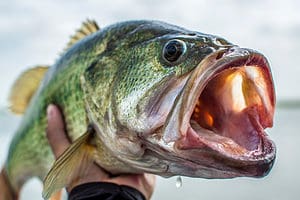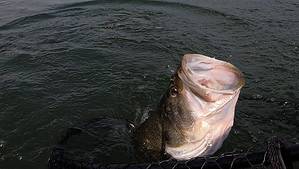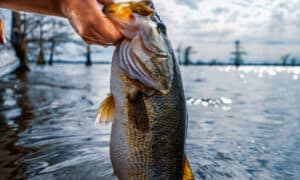Although Massachusetts is one of the smallest US states, it’s also one of the oldest and most densely populated. This lends it a rich history, especially when it comes to fishing! Even though the Bay State’s waters can be rather chilly depending on the time of year, the largemouth bass is more than hardy enough to tolerate them. Let’s take a look at the largest largemouth bass ever caught in Massachusetts below. We’ll also compare it to the current world record!
Get To Know The Largemouth Bass
The largemouth bass, or Micropterus salmoides, is one of North America’s most impressive native game fish for a number of reasons, chiefly its size. As its scientific name suggests, it is a member of the Micropterus genus, or simply “black basses.” Of the 13 unique species that make up this group, the largemouth is by far the largest, longest, and heaviest on average. In addition to being the largest species in its genus, it’s also the largest species of its entire family, Centrarchidae, which comprises 38 different species.
On average, an adult largemouth bass can range from around 12 to 24 inches long. Most individuals max out at around 16 inches. They grow and reach sexual maturity quickly, hitting their maximum size within their first two years of life. Their lifespan averages 10 to 15 years in the wild. Like most black basses, the largemouth is primarily dark olive green in color, with dark brown markings and a pale gray or white belly. Thin, bony rays hold up its strong fins.
As you might expect from such a large, muscular fish, the largemouth is a powerful apex predator. Extremely opportunistic and swift, it hides amongst aquatic vegetation, waiting for prey animals to cross its path. From smaller fish to invertebrates and even amphibians, almost nothing is off-limits when it comes to its usual menu. Some can even eat alligator hatchlings with relative ease!
While largemouth basses are exceptionally hardy and able to adapt to various freshwater environments, they prefer slow-moving, clear, warm waters with lots of vegetation nearby. They spawn once a year, typically in the spring, when water temperatures reach at least 60F. Females are larger than males, as they must carry large numbers of eggs.
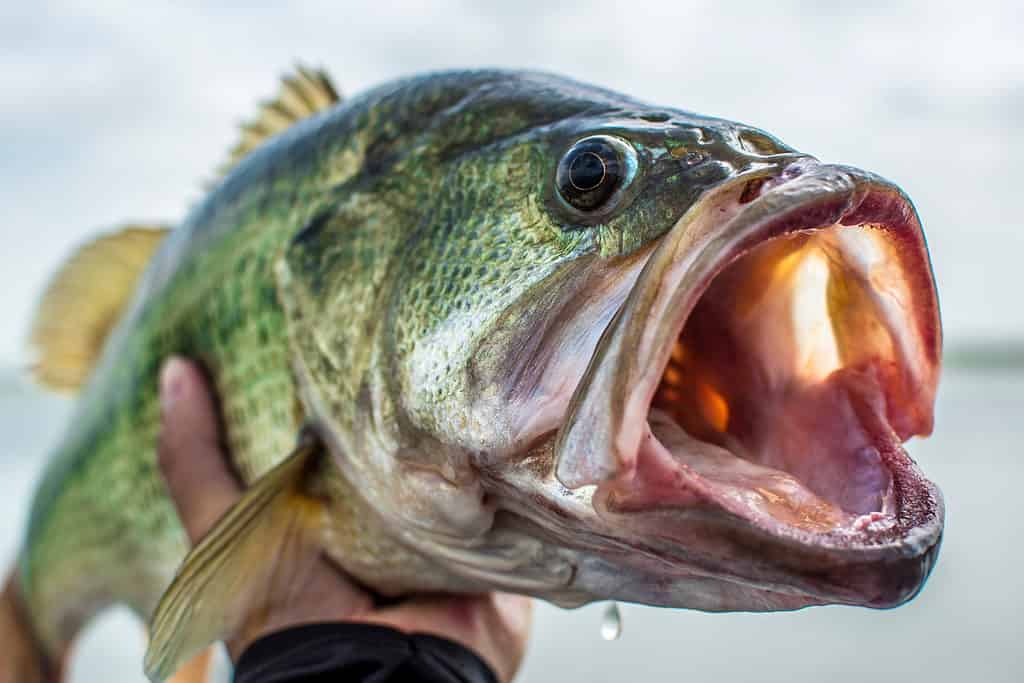
The largemouth bass, or
Micropterus salmoides, is one of North America’s most impressive native game fish for a number of reasons, chiefly its size.
©Pierre Rebollar/Shutterstock.com
The History Of Largemouth Bass Fishing
Among anglers, the largemouth bass is perhaps the most revered and impressive of all the black bass species. It has a rich history not only in North America, where it is native but also in areas where it has been introduced, such as Japan and Western Europe. Largemouth bass fishing as we know it today got its beginnings in the late 1800s.
Following the development of the steam engine, tank ponds cropped up across the Midwest. These tank ponds provided steam engines with water and the perfect habitat for various game fish. While most black basses were hardy enough to tolerate being transported hundreds of miles at a time, the largemouth was the one best suited to this task. In turn, this greatly expanded the largemouth’s natural range, making it more accessible to aspiring anglers.
Initially, fly fishing was the ideal method for catching largemouth bass. Early anglers developed their methods by adapting them from already-existing tactics they used to catch fish like trout and salmon. As the 1900s rolled around, the largemouth’s influence only continued to spread. In the 1940s and ‘50s, the US Department of Agriculture helped farmers stock and manage the tank ponds they established in the 1800s.
Furthermore, increased industrialization during this time made fishing supplies like lures cheaper to produce. Colorful, plastic worm lures became the norm, as production costs were low, and they were less expensive than the floating wooden lures that anglers previously used.
By the 1960s, tournaments dedicated to largemouth bass fishing were established, such as the B.A.S.S. Federation in 1961 and the Bassmaster Classic in 1971. Today, anglers use a wide range of techniques and lures for largemouths, from moving swimbaits to live baits like crayfish and worms.
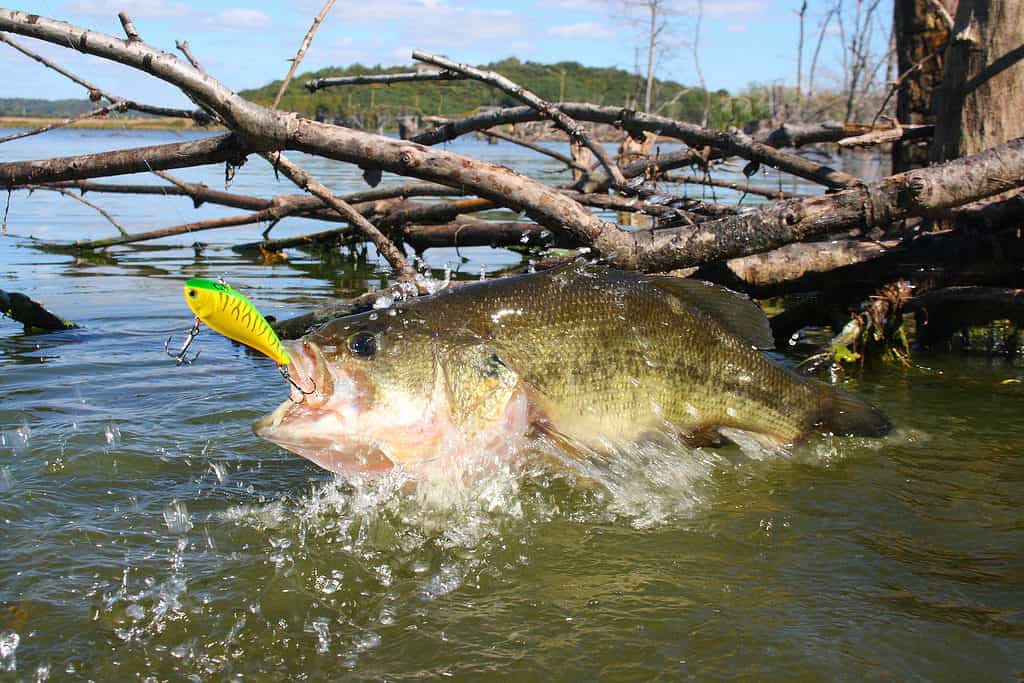
Largemouth basses are often found near laydowns or other structures where they can ambush their prey.
©iStock.com/stammphoto
How Big Do Largemouth Bass Get?
Between its immense physical strength, aggressive nature, and enormous size, it’s easy to see why most anglers revere the largemouth bass. As we mentioned earlier, it’s the largest member of both its genus (Micropterus; 13 species) and its entire family (Centrarchidae; 38 species), both by average length and weight.
Largemouth basses can actually range quite widely in size. They can vary from as small as 12 inches to well over 25 inches long. Most adult individuals reach somewhere between 16 and 20 inches long. Some say that they saw largemouth basses over three feet in length, though specimens of this size are very rare. In terms of weight, largemouths are similarly exceptional, with the typical fully-grown adult averaging around 12 pounds. They reach sexual maturity quickly, usually at around 1 to 2 years old, and maintain their size for the majority of their 10-to-15-year lifespan.
Much of the largemouth’s signature combative nature, or “fight,” is thanks to its bulky, muscular body and overall large size. As an apex predator, it can easily eat prey up to around half of the size of its own body!
What Is The Largest Largemouth Bass Ever Caught In Massachusetts?
Now that we have a better idea of just how large largemouth bass typically grow, let’s take a look at the largest specimen ever caught in Massachusetts! Like most US states, Massachusetts’ Division of Fisheries and Wildlife conveniently keeps track of the largest game fish caught in the state.
According to Massachusetts’ freshwater fish records, the state’s largest largemouth bass ever caught was an impressive 15 pounds, 8 ounces. It was 28 inches long. What’s most incredible about this record, however, is that it has stood unchallenged for more than 40 years!
The record-breaking fish in question was caught by angler Walter Bolonis back in 1975. The Massachusetts Division of Fisheries and Wildlife currently lists no precise date for the catch. However, other sources like Telegram claim Bolonis caught the fish on February 13th.
Bolonis caught the 15-pounder at Sampson Pond in Carver, Massachusetts. The town of Carver is located in Plymouth County. The pond is around 300 acres in size with an average depth of around 8 feet. In addition to largemouths, it boasts a diverse population of game fish such as bluegill, yellow and white perch, chain pickerel, and golden shiners.

The Walden Pond near Concord, Massachusetts. In addition to largemouths, the state boasts a diverse population of game fish such as bluegill, yellow and white perch, chain pickerel, and golden shiners.
©iStock.com/AlizadaStudios
What Is The World’s Largest Largemouth Bass Ever Caught?
Massachusetts’ largest largemouth bass is pretty amazing, but how does it compare to the world’s largest specimen? Incredibly, Bolonis’ catch is still about 7 pounds short of the world record!
Interestingly, though, the current world record is actually shared by two anglers from different ends of the globe. What’s more, their respective catches are more than 70 years apart. This is because of an International Game Fish Association regulation that states record-breaking catches must be at least two ounces larger than the previous record.
The first world record was established all the way back in 1932 by angler George W. Perry of Rentz, Georgia. When he was just 19 years old at the time, Perry caught a 22-pound, 4-ounce largemouth bass at Telfair County, Georgia’s Montgomery Lake. Even today, Montgomery Lake has a historic marker dedicated to Perry’s catch, and the area has long remained a popular fishing destination.
Around 77 years later, though, a challenger appeared: angler Manabu Kurita, of Aichi, Japan. On July 2nd, 2009, he caught a 22-pound, 5-ounce largemouth bass at Japan’s historic Lake Biwa. Lake Biwa is located in the Shiga Prefecture, northeast of Kyoto.
Because Kurita and Perry’s catches are only about an ounce apart, they both hold the IGFA world record! Perhaps in the future, a new angler will land an even larger largemouth, but nobody has challenged the record just yet.
Where Is Carver, Massachusetts Located On A Map?
The town of Carver is located in Massachusetts, which is in New England in the Northeast of the United States. Massachusetts is bordered by New Hampshire and Vermont to the north, Connecticut and Rhode Island to the south, New York to the east, and the Atlantic Ocean and the Gulf of Maine to the east. Carver is in Plymouth County and is approximately 45 miles southeast of Boston and 38 miles east of Providence, Rhode Island.
The photo featured at the top of this post is © iStock.com/stammphoto
Thank you for reading! Have some feedback for us? Contact the AZ Animals editorial team.



